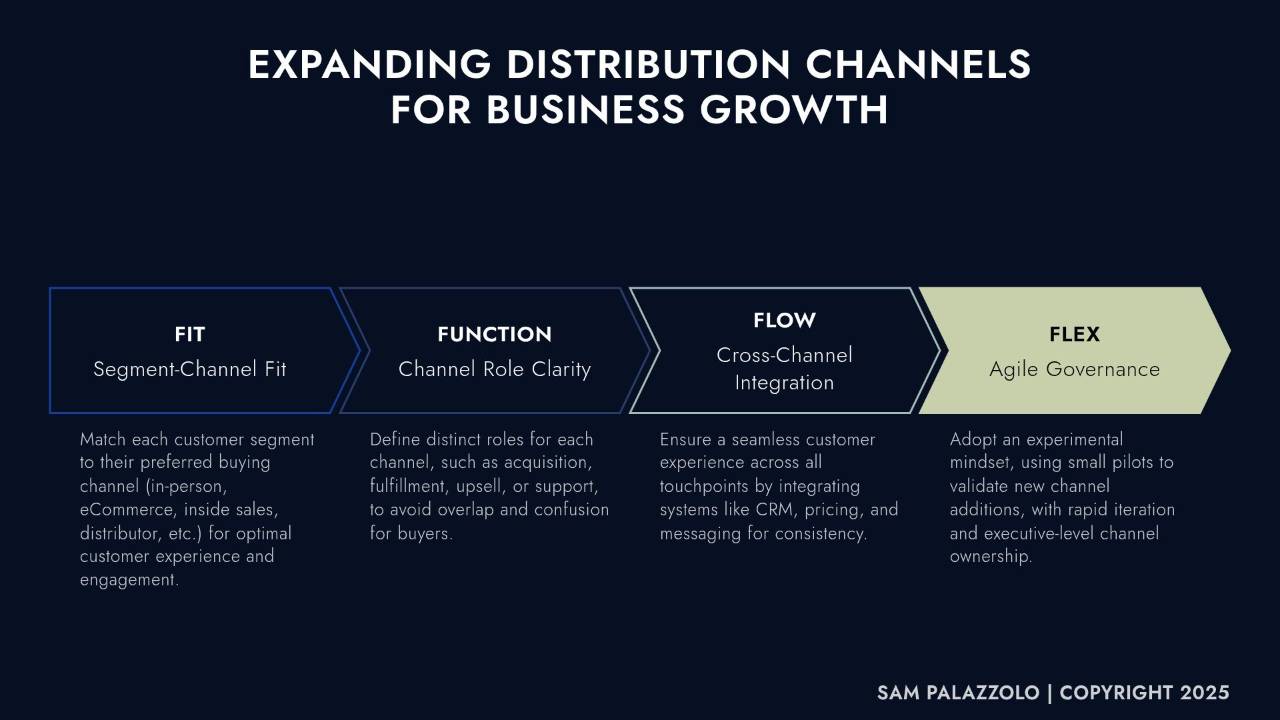Expanding Distribution Channels: The Overlooked Growth Multiplier
Aug 04, 2025
When growth stalls, most organizations default to sales training, marketing spend, or new product development. But one of the most overlooked and underleveraged levers for revenue acceleration is also one of the most scalable: distribution channel expansion.
Research from McKinsey & Company shows that 71% of top-performing companies operate across four or more distribution channels. Similarly, PwC found that companies that actively expand their distribution reach grow three times faster than those who do not. The message is clear: strategic channel diversification is not a luxury—it’s a necessity.
Why Distribution Channels Matter More Than Ever
In an era where customer behaviors shift rapidly and digital adoption has shortened sales cycles, relying on one or two go-to-market paths can leave even well-positioned companies vulnerable.
Today’s buyers expect flexibility. Some prefer a high-touch enterprise sales process, while others want frictionless self-service. Distributors, marketplaces, partner ecosystems, and even customer success teams now play roles in revenue generation. The question is no longer whether to expand channels—but how to do so without introducing chaos, channel conflict, or cost inefficiencies.
Common Pitfalls When Expanding Channels
Despite the upside, expanding distribution isn’t without risks. Leaders often encounter:
- Channel Conflict – When new routes cannibalize or compete with existing ones.
- Lack of Data Integration – Fragmented customer insights across platforms hinder decision-making.
- Operational Complexity – Managing multiple channels strains teams and systems.
- Incentive Misalignment – Sales teams, partners, and digital tools often work in silos.
- Localization Failures – New markets demand tailored approaches, not carbon copies of domestic strategies.
These issues are not merely operational—they’re strategic. Left unresolved, they can erode brand equity and customer trust.
A Strategic Framework for Channel Expansion
To navigate complexity and ensure sustainable growth, a deliberate approach is critical. A four-part model—adapted from McKinsey’s omnichannel research—provides a clear path forward.
Fit: Segment-Channel Alignment
Start with your customers. Different buyer personas prefer different purchasing experiences. A mid-market customer may prefer a self-serve platform, while an enterprise buyer may want consultative sales and contract negotiation. Mapping each segment to its ideal channel improves conversion rates and reduces churn.
Action: Conduct a buyer journey audit. Where do your customers want to meet you—and where are you forcing them to buy in ways that don’t match their expectations?
Function: Role Clarity Across Channels
Each channel must serve a defined purpose. Confusion arises when both your direct sales team and a channel partner try to “own” the same buyer journey. Define distinct roles such as acquisition, fulfillment, support, or upsell for every channel.
Action: Document the functional ownership of each sales and service activity. Then map these to your internal teams, partner ecosystems, and digital tools.
Flow: Cross-Channel Integration
Systems integration is critical. Disconnected CRMs, inconsistent pricing, and mismatched messaging across channels lead to poor customer experiences and internal friction.
Action: Align back-end systems and front-line messaging. Ensure all channels operate with unified customer data, pricing logic, and brand voice.
Flex: Agile Channel Governance
Rather than launching full-scale new channels, start with small pilots. Use agile sprints to test hypotheses, iterate based on feedback, and establish performance benchmarks. Assign an executive owner for each channel to drive accountability.
Action: Build a 90-day pilot roadmap for any new distribution method, including specific KPIs, a defined feedback loop, and clear executive sponsorship.
Real-World Example: From Stalled Sales to Scalable Systems
A B2B software firm recently faced stagnating growth. Despite high retention and a strong product-market fit, net-new revenue had plateaued. The root cause? Overreliance on an outbound enterprise sales team.
Through a strategic channel audit, the company identified two underserved customer segments: small teams that preferred self-service onboarding, and enterprise clients who wanted value-added services through consulting partners.
By launching a limited-scope eCommerce portal and creating a partner enablement program for resellers, they were able to unlock both segments within a single quarter. The result: a 28% reduction in CAC and a 33% lift in qualified pipeline value within six months.
Why This Matters for Strategic Leaders
Expanding distribution channels isn’t a tactical initiative—it’s a growth multiplier. Done right, it unlocks:
- Greater customer reach with lower marginal cost
- De-risked growth through channel diversification
- Increased operational leverage without overextending core teams
But it only works when it’s led from the top. Channel strategy is not a sales decision—it’s a leadership mandate.
Closing Thoughts: Lead with Clarity, Scale with Confidence
The fastest-growing organizations in the world understand that distribution isn’t just about getting your product to market—it’s about designing the market experience itself. As customer expectations continue to evolve, leaders who invest in flexible, data-informed, and integrated channel strategies will find themselves not just expanding reach—but accelerating impact.
For more strategies like this delivered weekly, subscribe to the Business Scaling newsletter:
https://sampalazzolo.com
Sam Palazzolo
Real Strategies. Real Results.
SUBSCRIBE FOR WEEKLY BUSINESS SCALING STRATEGIES
REAL STRATEGIES. REAL SOLUTIONS.
We respect your privacy. Unsubscribe at any time.
